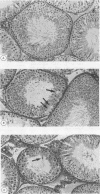Abstract
Male Wistar rats were exposed to ethylene oxide (EO) at concentrations of 50, 100, or 250 ppm for six hours a day, on five days a week for 13 weeks. Dose effect relations of inhaled EO on spermatogenesis were evaluated from testicular and epididymal weights, histopathological changes and lactate dehydrogenase X (LDH X) activity in the testis, and sperm counts and sperm head abnormalities in the epididymis. At 250 ppm, a decrease in epididymal weights, slight degenerations in the seminiferous tubules, decreased sperm counts, and increased numbers of abnormal sperm heads in the tail of the epididymis were found; these were not seen at lower doses. When the abnormal sperm heads were classified into immature types and teratic types, the number of immature heads increased only at 250 ppm. On the other hand, the teratic type had increased at doses of 50 and 100 ppm EO when compared with the control group. Hence, subchronic inhalation of EO at low concentrations affects spermatogenesis in rats.
Full text
PDF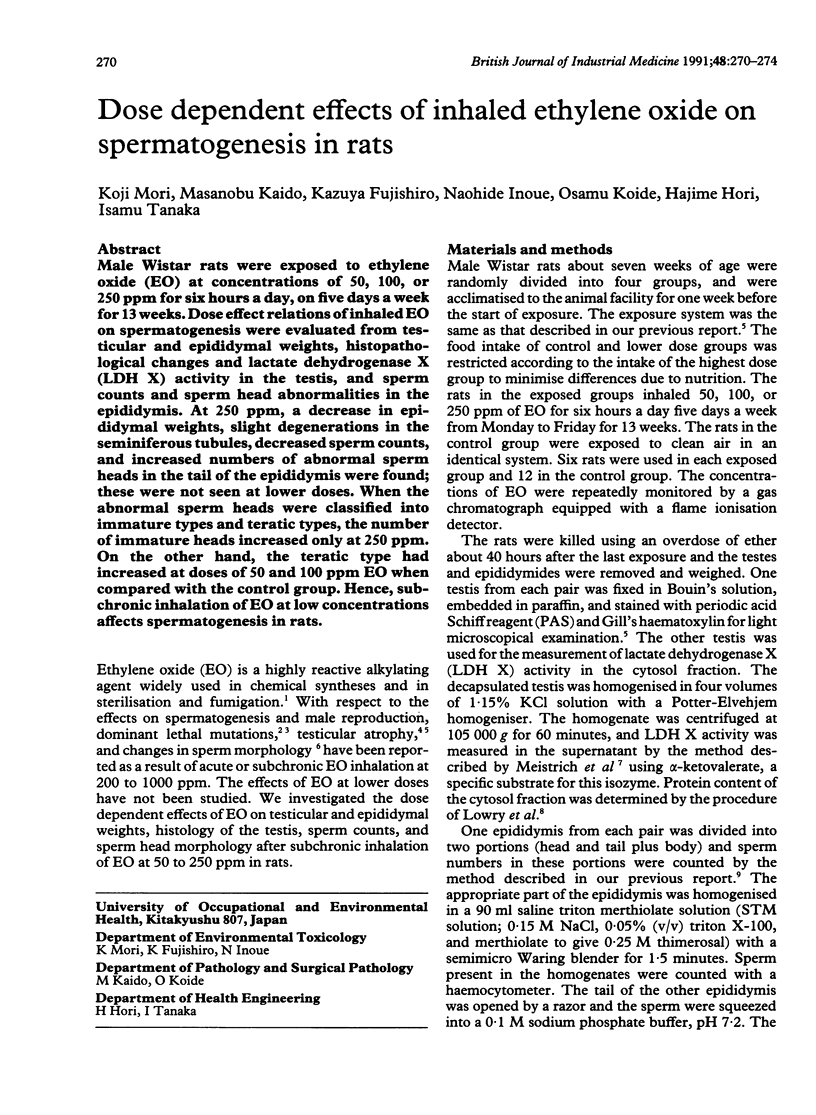
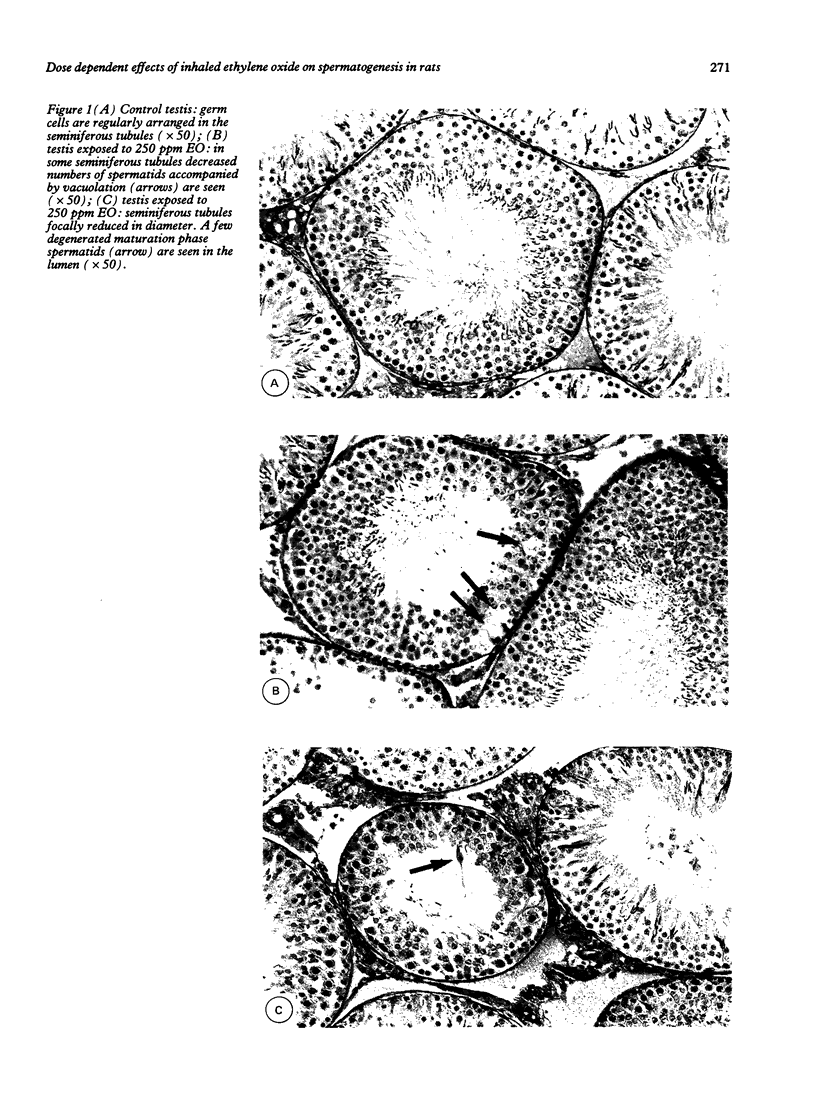
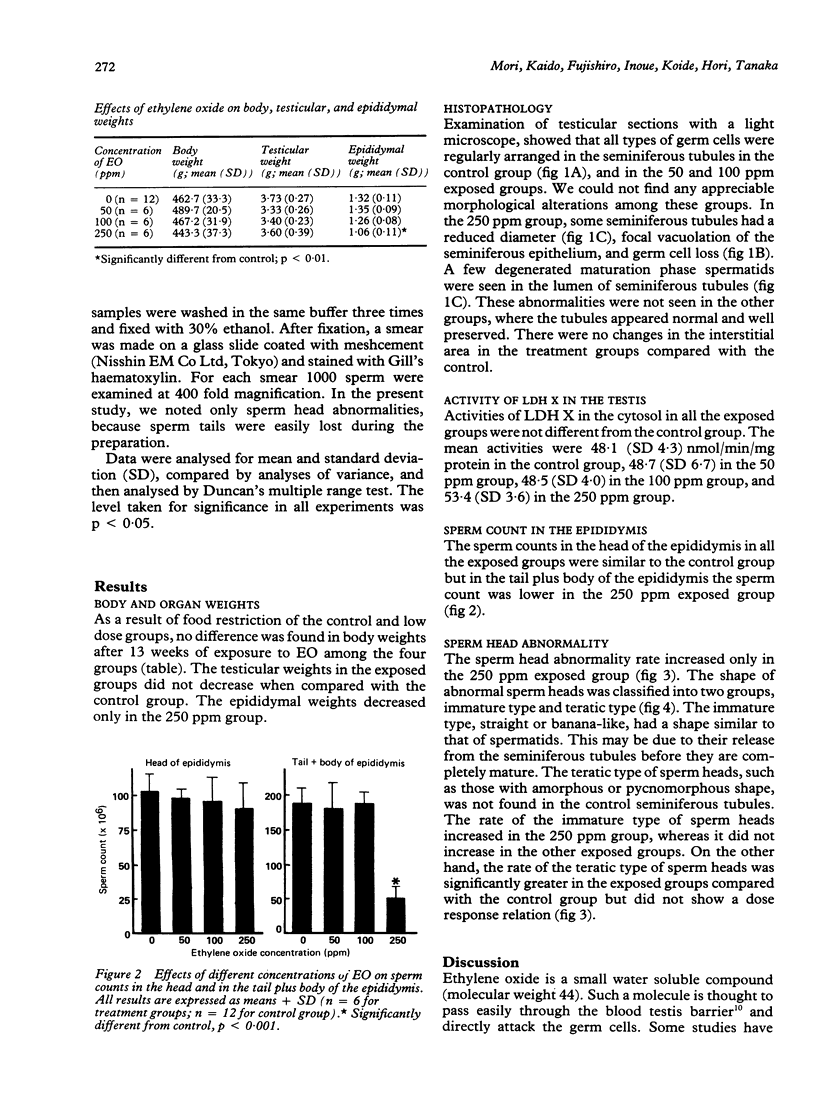
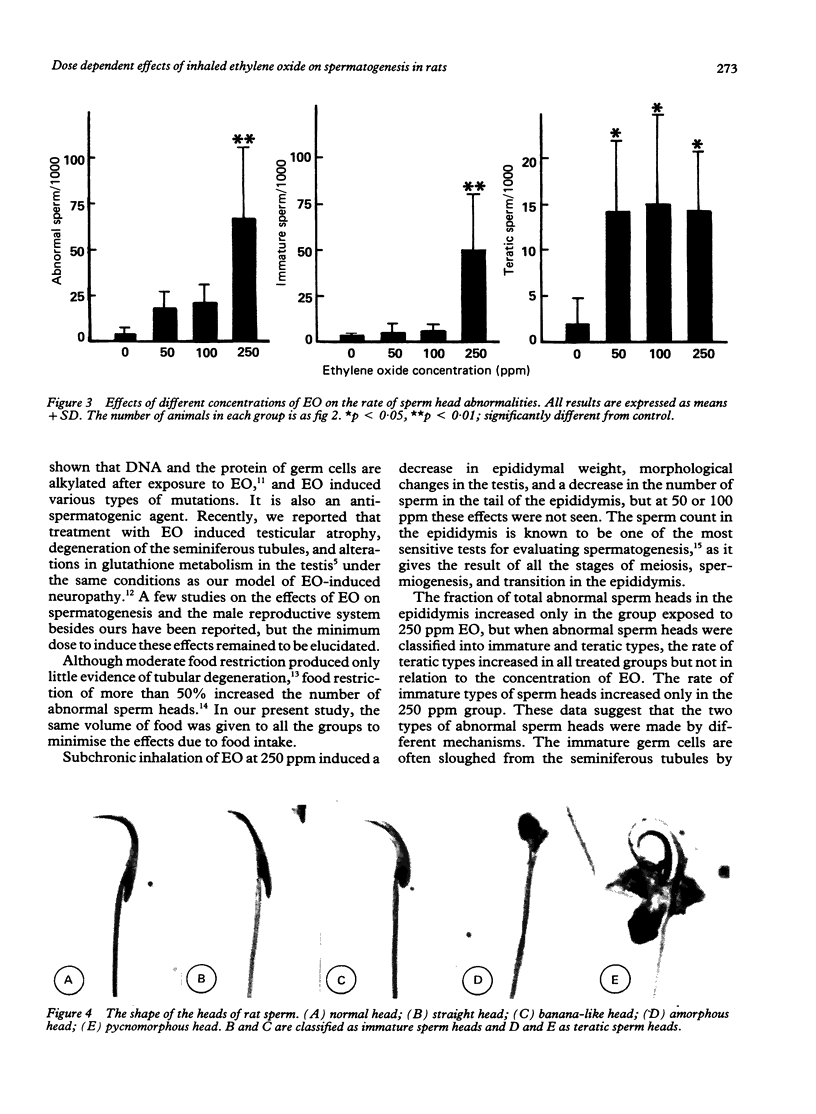
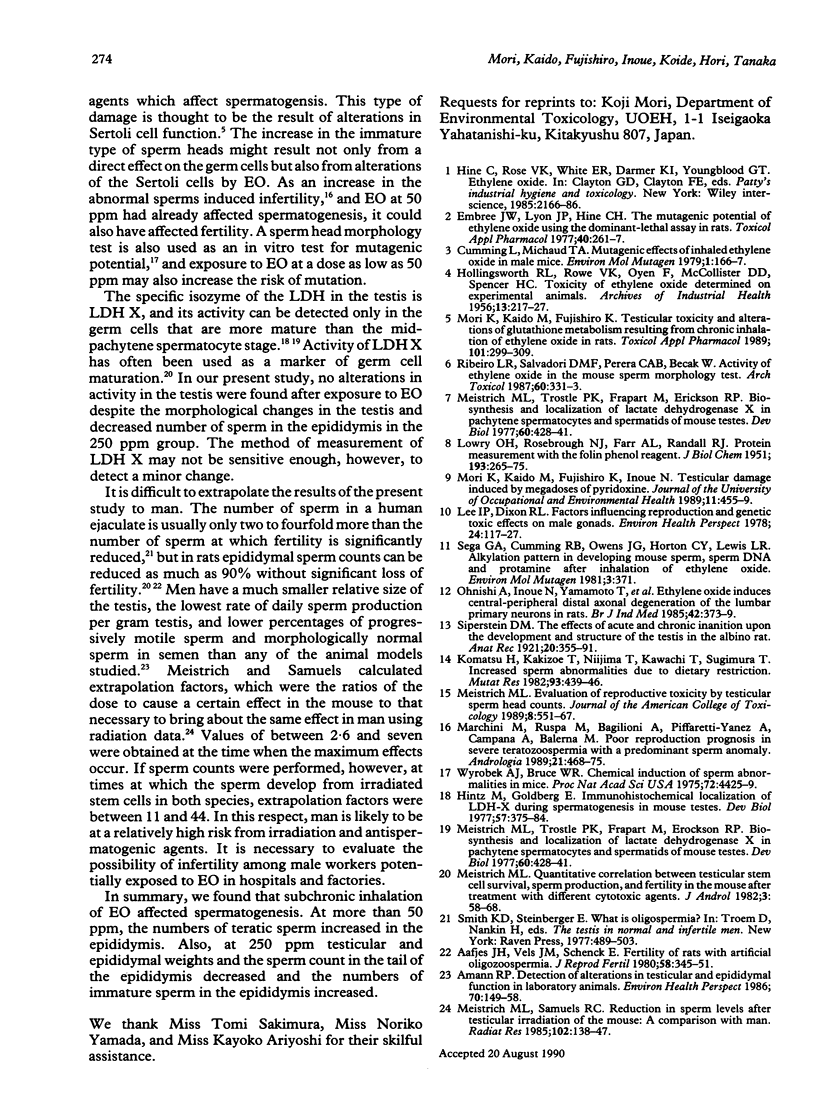
Images in this article
Selected References
These references are in PubMed. This may not be the complete list of references from this article.
- Aafjes J. H., Vels J. M., Schenck E. Fertility of rats with artificial oligozoospermia. J Reprod Fertil. 1980 Mar;58(2):345–351. doi: 10.1530/jrf.0.0580345. [DOI] [PubMed] [Google Scholar]
- Amann R. P. Detection of alterations in testicular and epididymal function in laboratory animals. Environ Health Perspect. 1986 Dec;70:149–158. doi: 10.1289/ehp.8670149. [DOI] [PMC free article] [PubMed] [Google Scholar]
- Embree J. W., Lyon J. P., Hine C. H. The mutagenic potential of ethylene oxide using the dominant--lethal assay in rats. Toxicol Appl Pharmacol. 1977 May;40(2):261–267. doi: 10.1016/0041-008x(77)90096-5. [DOI] [PubMed] [Google Scholar]
- HOLLINGSWORTH R. L., ROWE V. K., OYEN F., MCCOLLISTER D. D., SPENCER H. C. Toxicity of ethylene oxide determined on experimental animals. AMA Arch Ind Health. 1956 Mar;13(3):217–227. [PubMed] [Google Scholar]
- Hintz M., Goldberg E. Immunohistochemical localization of LDH-x during spermatogenesis in mouse testes. Dev Biol. 1977 Jun;57(2):375–384. doi: 10.1016/0012-1606(77)90222-6. [DOI] [PubMed] [Google Scholar]
- LOWRY O. H., ROSEBROUGH N. J., FARR A. L., RANDALL R. J. Protein measurement with the Folin phenol reagent. J Biol Chem. 1951 Nov;193(1):265–275. [PubMed] [Google Scholar]
- Lee I. P., Dixon R. L. Factors influencing reproduction and genetic toxic effects on male gonads. Environ Health Perspect. 1978 Jun;24:117–127. doi: 10.1289/ehp.7824117. [DOI] [PMC free article] [PubMed] [Google Scholar]
- Marchini M., Ruspa M., Baglioni A., Piffaretti-Yanez A., Campana A., Balerna M. Poor reproductive prognosis in severe teratozoospermia with a predominant sperm anomaly. Andrologia. 1989 Sep-Oct;21(5):468–475. [PubMed] [Google Scholar]
- Meistrich M. L., Samuels R. C. Reduction in sperm levels after testicular irradiation of the mouse: a comparison with man. Radiat Res. 1985 Apr;102(1):138–147. [PubMed] [Google Scholar]
- Meistrich M. L., Trostle P. K., Frapart M., Erickson R. P. Biosynthesis and localization of lactate dehydrogenase X in pachytene spermatocytes and spermatids of mouse testes. Dev Biol. 1977 Oct 15;60(2):428–441. doi: 10.1016/0012-1606(77)90140-3. [DOI] [PubMed] [Google Scholar]
- Meistrich M. L., Trostle P. K., Frapart M., Erickson R. P. Biosynthesis and localization of lactate dehydrogenase X in pachytene spermatocytes and spermatids of mouse testes. Dev Biol. 1977 Oct 15;60(2):428–441. doi: 10.1016/0012-1606(77)90140-3. [DOI] [PubMed] [Google Scholar]
- Mori K., Kaido M., Fujishiro K., Inoue N. Testicular damage induced by megadoses of pyridoxine. J UOEH. 1989 Dec 1;11(4):455–459. doi: 10.7888/juoeh.11.455. [DOI] [PubMed] [Google Scholar]
- Mori K., Kaido M., Fujishiro K., Inoue N. Testicular toxicity and alterations of glutathione metabolism resulting from chronic inhalation of ethylene oxide in rats. Toxicol Appl Pharmacol. 1989 Nov;101(2):299–309. doi: 10.1016/0041-008x(89)90278-0. [DOI] [PubMed] [Google Scholar]
- Ohnishi A., Inoue N., Yamamoto T., Murai Y., Hori H., Koga M., Tanaka I., Akiyama T. Ethylene oxide induces central-peripheral distal axonal degeneration of the lumbar primary neurones in rats. Br J Ind Med. 1985 Jun;42(6):373–379. doi: 10.1136/oem.42.6.373. [DOI] [PMC free article] [PubMed] [Google Scholar]
- Ribeiro L. R., Salvadori D. M., Pereira C. A., Beçak W. Activity of ethylene oxide in the mouse sperm morphology test. Arch Toxicol. 1987 Jun;60(4):331–333. doi: 10.1007/BF01234675. [DOI] [PubMed] [Google Scholar]
- Wyrobek A. J., Bruce W. R. Chemical induction of sperm abnormalities in mice. Proc Natl Acad Sci U S A. 1975 Nov;72(11):4425–4429. doi: 10.1073/pnas.72.11.4425. [DOI] [PMC free article] [PubMed] [Google Scholar]



